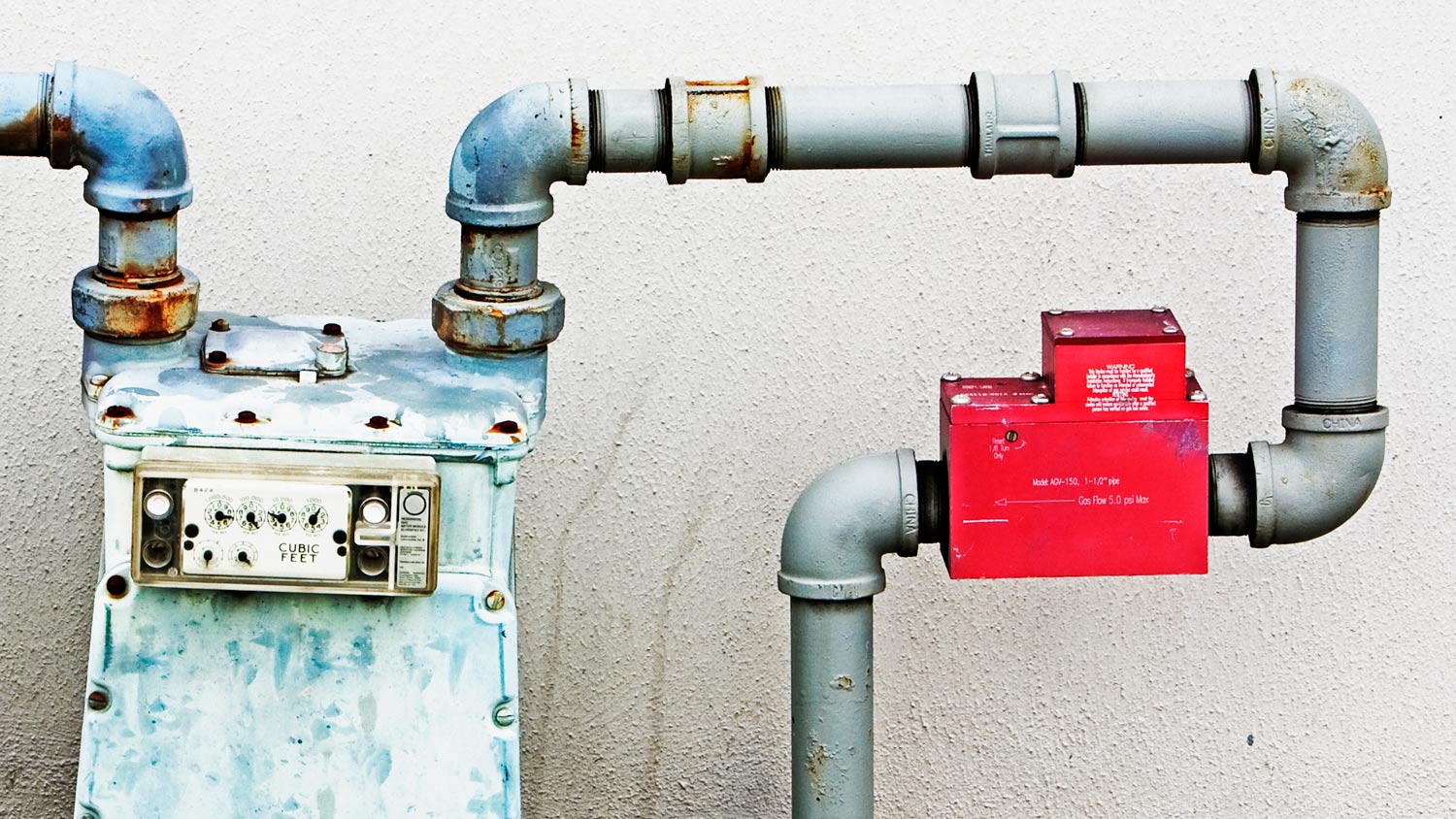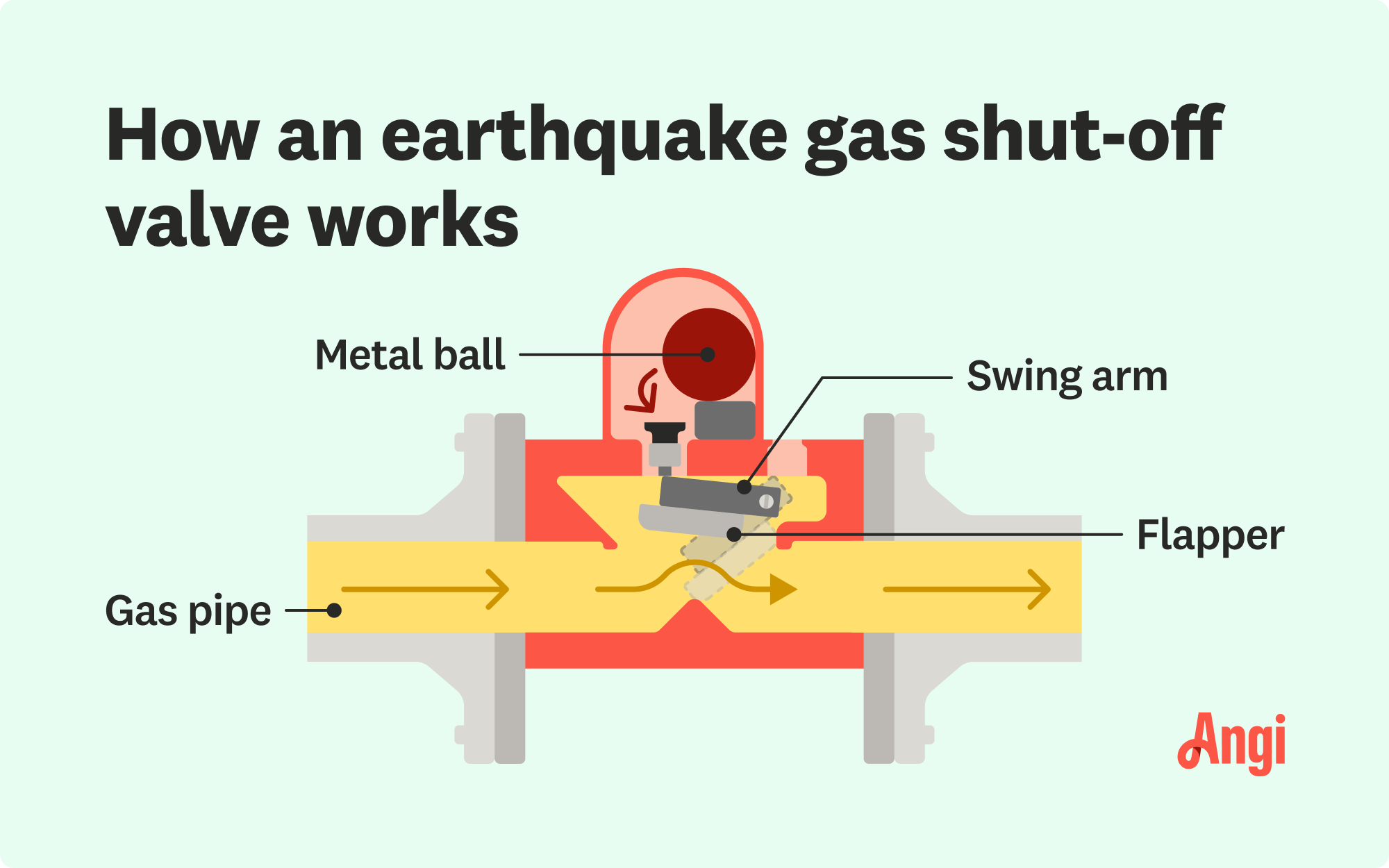What Is an Earthquake Gas Shut-Off Valve and Do You Need One?
This little device could be a lifesaver


An earthquake gas shut-off valve stops gas flow during shaking or gas leaks.
The purpose of this valve is to prevent toxic gas leaks after an earthquake.
An excess flow valve shuts off gas in response to a gas leak or high pressure.
Some cities or states require earthquake gas shut-off valves.
Installing an earthquake gas shut-off valve costs about $250 to $750.
When an earthquake rolls into town, it can cause fear and panic to set in, especially if it causes damage to your home. But earthquakes can quietly cause hidden danger if they lead to a burst pipe or gas leak—which you may not be able to detect on your own. Thankfully, an earthquake gas shut-off valve can stop a gas leak and keep your family safe. Here’s everything you need to know about this device, from how it works to laws and regulations to the installation cost.
What Is an Earthquake Gas Shut-Off Valve?

An earthquake gas shut-off valve is a device that connects to your gas meter and closes to stop the gas supply to your home in an emergency because of shaking from an earthquake of a certain magnitude, leaking, or high pressure in the gas pipes. There are two types of valves: a seismic gas shut-off valve (also called an earthquake shake-actuated valve) and an excess flow valve. An excess flow valve shuts off gas when it detects a gas leak or high gas pressure. Both can cut the gas supply to keep your family safe, and you may even consider installing both types for more protection.
How Do Earthquake Gas Shut-Off Valves Work?
Earthquake gas shut-off valves work by closing to stop the gas supply from reaching the house, but each type of valve works differently depending on its use.

The seismic gas shut-off valve has a metal ball that goes into the gas pipe that connects the gas meter to the house. When shaking starts, the ball drops into the main gas line below to stop the gas flow.
Instead of reacting to shaking, an excess flow valve detects gas leaks or surges of high pressure (which could happen during an earthquake) and senses when gas is flowing too fast. When either occurs, the valve closes to stop the gas flow.
Importance of Earthquake Gas Shut-Off Valves
The whole purpose of an earthquake gas shut-off valve is safety. Gas leaks or pressure buildup are extremely dangerous and can happen when shaking causes damage to pipes. If gas leaks into your home, it is poisonous. The gas is also flammable and could lead to a fire or explosion. The Earthquake Country Alliance reports that one in four fires after an earthquake are linked to natural gas leaks.
Rather than rushing to the gas meter to manually shut off the gas after a destructive earthquake, the valve automatically handles this, increasing your safety and giving you one less thing to worry about.
How to Install an Earthquake Gas Shut-Off Valve
While you can’t install an earthquake gas shut-off valve yourself, a professional natural gas plumber can handle this project. First, your plumber will need to secure a building permit, and you’ll need to buy a valve that fits your gas pipes.
To install the valve, your plumber will start by turning off the gas supply and detaching the meter. Then, your plumber will attach the valve to the gas pipe and reconnect the pipe to the meter. They’ll brace the earthquake gas shut-off valve to ensure it can properly react to earthquake shaking without turning off from less significant bumps. Then, they will inspect for leaks and turn your gas supply back on.
Where Is the Earthquake Shut-Off Valve Installed?
A pro will install the earthquake gas shut-off valve on your gas meter outside your house. The valve will look like a small dome or rectangular unit attached to the pipe between the gas meter and the building.
How Do I Reset My Earthquake Shut-Off Valve?
Whenever your earthquake shut-off valve engages, you’ll need to reset it before you can use the gas in your home again. Earthquakes will trigger your shut-off valve, but so can someone accidentally bumping into it. Since working with gas is dangerous, it’s a good idea to hire a pro to reset the valve.
If you’d like to reset the valve yourself, first ensure the gas is off and there’s no pressure in the line. A gas plumber must also confirm there are no gas leaks before resetting the valve.
Look for a small circular or oval-shaped display on the top of the valve that will be red or green. If it’s red, the valve was triggered and needs a reset. Next, look for the reset screw, which is sometimes labeled with the word “reset.” Use a flathead screwdriver and turn it clockwise (an eighth of a turn) or until you see the display turning green.
Earthquake Gas Shut-Off Valve Regulations
Because earthquake shut-off valves are so critical to safety, many municipalities and states in earthquake-prone areas require them or have strict regulations about proper installation or the type of valve you can install. For instance, in California, any building constructed after 2000 must have earthquake shut-off valves by law.
Some insurance companies require people with homeowners or earthquake insurance policies to install an earthquake gas shut-off valve, as well. Consult with your utility supplier and your insurance company to determine which requirements you need to follow when installing a gas shut-off valve.
Even if your city doesn’t require you to install a valve, it’s a worthy investment if you live in an area prone to earthquakes. An excess flow valve can also be handy for keeping your home safe from gas leaks that aren’t caused by earthquakes.
Earthquake Gas Shut-Off Valve Installation Cost
Installing an earthquake gas shut-off valve costs about $250 to $750 for parts and labor. This isn’t something you can DIY—you’ll need a professional, authorized natural gas plumber to install this device.
Installing the shut-off valve could be part of a larger earthquake retrofit, which prepares your home to withstand shaking. If you hire a foundation repair specialist in your area, retrofitting might include bolting the foundation to prevent the home from sliding, bracing crawl space walls to minimize the risk of collapse, filling or reinforcing chimneys, and bracing any soft-story dwellings. An earthquake retrofit costs $3,500 to $8,700.
Hiring a Pro for Installation
In most cases, only authorized contractors or utility workers are legally allowed to install an earthquake gas shut-off valve, as handling gas plumbing comes with serious risks. Incorrectly installing the valve could cause a gas leak, and it’s toxic to breathe in and highly flammable.
If you need to install a new earthquake gas shut-off valve or replace an old one, hire a local natural gas plumber to handle the project. Make sure they have the proper certifications, and contact your utility company for more information about installation regulations and who is allowed to do this work.
Frequently Asked Questions
The best way to reset this valve is to contact your utility provider to do so safely. If the pipes are damaged and you reset the valve anyway, it could lead to a gas leak. It’s important to call in a pro as soon as you can to reconnect your gas supply after an earthquake and ensure the device will work again the next time there’s a quake.
Some cities or states may require you to have an earthquake gas shut-off valve. Your insurance provider may also have requirements for installing this valve. Even if you don’t have to have one by law, it’s wise to have a natural gas plumber install one anyway. These devices can be lifesaving and prevent fires or explosions in the event of a gas leak.




- Earthquake Retrofit 101: Everything You Need to Know About Prepping a Home for a Seismic Event
- Where Can I Find My Irrigation Shut-Off Valve’s Location?
- Signs of a Gas Leak: Everything You Need to Know
- My Gas Oven Smells Like Gas Whether On or Off, Not the Stove Top. What Would Cause This?
- Who Fixes Gas Stoves?
- What to Do if Your Gas Stove Was Left on Without a Flame
- How Safe Are Your Natural Gas Pipes?
- Why Your Oven Smells Like Gas and What To Do About It
- How Long Does Earthquake Retrofitting Take?
- Why Is My Gas Stove Not Lighting? 11 Common Issues











